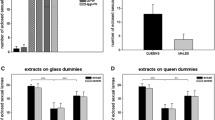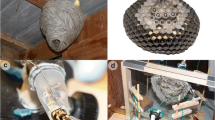Summary
The populations and mean individual weight of queens and workers have been obtained from a sample of colonies for three species ofMyrmica; beingMyrmica rubra L.,Myrmica sabuleti Meinert andMyrmica scabrinodis Nylander.
It was found thatM. scabrinodis have fewer and smaller workers than the other two species but the most important differences are in the queen populations.M. rubra average 15 queens per colony,M. sabuleti 3 andM. scabrinodis 2 while some colonies of bothM. rubra andM. sabuleti contain microgynes. There are usually some normal queens in microgynes colonies, slightly fewer than in normal colonies, but there are many more queens altogether. Microgyne colonies ofM. rubra average 60 queens and those ofM. sabuleti 20 queens.M. sabuleti normal queens weigh 6.3 mg, microgynes 3.8 mg,M. rubra normals 5.6 mg, microgynes 2.7 mg andM. scabrinodis 4.7 mg.
Queen numbers have a negative influence on the mean individual weights of queens and workers in a colony whilst worker number has a positive influence. An important inplication of this observation is thatMyrmica colonies must tend to recruit daughters, rather than strangers, to add to and replace the foundress queens. This seems to be so even inM. scabrinodis that often has only one queen in a colony.
It is suggested that these size relationships can be explained by the «queen effect», that has been well investigated in the laboratory. It is proposed that the greater the queen density (queens/worker) the greater the probability of an individual worker being under the influence of a queen and carrying out «queen effect» on the larvae, although this relationship is not linear. The results imply that perhapsM. sabuleti queens and microgynes of bothM. sabuleti andM. rubra do not have the same «queen effect» on larvae as do queens ofM. rubra andM. scabrinodis.
Finally a diagram of the probable interactions between size and population of individuals in aMyrmica colony is presented and discussed.
Zusammenfassung
Die Bevölkerungen und mittleren Gewichte von Königinnen und Arbeiterinnen wurden an Proben aus Kolonien von drei Arten vonMyrmica (Myrmica rubra, L.,Myrmica sabuleti Meinert undMyrmica scabrinodis Nylander), bestimmt.
M. scabrinodis hat weniger und kleinere Arbeiterinnen als die anderen beiden Arten, doch bestehen die wichtigsten Unterschiede zwischen den Königinnen.M. rubra hat im Durchschnitt 15 Königinnen je Kolonie,M. sabuleti 3 undM. scabrinodis 2, wobei manche Kolonien vonM. rubra undM. sabuleti mikrogyne Königinnen enthalten. In der Regel gibt es in Mikrogynkolonien einige normale Königinnen, etwas weniger als in normalen Kolonien, doch ist die Gesamtzahl der Königinnen bedeutend größer. Mikrogynkolonien vonM. rubra enthalten im Durchschnitt 60 und die vonM. sabuleti 20 Königinnen. Normale Königinnen vonM. sabuleti wiegen 6,3 mg, Mikrogyne 3,8 mg; normale Königinnen vonM. rubra wiegen 5,6 mg, Mikrogyne 2,7 mg und Königinnen vonM. scabrinodis wiegen 4,7 mg.
Die Anzahl der Königinnen übt einen negativen Einfluß auf die mittleren Gewichte der Königinnen und der Arbeiterinnen in einer Kolonie aus, während die Anzahl der Arbeteirinnen einen positiven Einfluß bewirkt. Daraus läßt sich der wichtige Schluß ziehen, daßMyrmica Kolonien zusätzlich zu und als Ersatz der Stammköniginnen Töchter rekrutieren müssen, und nicht fremde Königinnen. Dies scheint selbst beiM. scabrinodis der Fall zu sein, bei der eine Kolonie oft nur eine einzige Königin enthält.
Es wird angenommen, daß diese Größnverhältnisse durch den «Königinneneffekt» erklärt werden können, der im Labor gründlich erforscht worden ist, da es umso wahrscheinlicher ist, daß eine Arbeiterin unter dem Einfluß einer Königin steht und die «Königinneneffekt» auf die Larven ausübt, je größer die Königinnendichte (Verhältnis von Königinnen zu Arbeiterinnen) ist, doch ist diese Beziehung nicht linear. Die Ergebnisse deuten darauf hin, daß vielleicht Königinnen vonM. sabuleti sowie Mikrogynen vonM. sabuleti undM. rubra nicht dieselbe «Königinneneffekt» auf Larven ausüben wie die Königinnen vonM. rubra undM. scabrinodis.
Schließlich wird ein Diagramm der wahrscheinlichen Wechselwirkungen zwischen Körpergröß und Bevölkerungsdichte der Individuen in einerMyrmica-Kolonie dargestellt und erörtert.
Similar content being viewed by others
References
Brian (M. V.), 1950. — The stable winter population structure in species ofMyrmica.J. Anim. Ecol., 19, 119–123.—Brian (M. V.), 1965. Social insect populations.Academic Press, publ. New York.—Brian (M. V.), 1970. Communication between queens and larvae in the antMyrmica. Anim. Behav., 18, 467–472.—Brian (M. V.), 1972. Population turnover in wild colonies of the antMyrmica. Ecologia Polska, 10 (5), 43–53.
Brian (M. V.) andBrian (A. D.), 1951. — Insolation and ant population in the West of Scotland.Trans. R. ent. Soc. Lond., 102, 303–330.
Brian (M. V.) andCarr (C. A. H.), 1960. — The influence of the queen on brood rearing in ants of the genusMyrmica.J. Ins. Physiol., 5, 81–94.
Brian (M. V.) andKelly (A. F.), 1967. — Studies of caste differentiation inMyrmica rubra L. 9. Maternal environment and the caste bias of larvae.Ins. Soc., 14, 13–24.
Elmes (G. W.), 1973a. — Miniature queens of the antMyrmica rubra L. (Hymenoptera, Formicidae).The Entomologist (June).—Elmes (G. W.), 1973b. Observations on the density of queens in natural colonies ofMyrmica rubra L. (Hymenoptera, Formicidae).J. Anim. Ecol., 42, 761–772.—Elmes (G. W.), 1975. The spatial distribution of a population of two ant species living in limestone grassland.Pedobiologia (in press).
Mountford (M. D.), 1971. — Population survival in a variable environment.J. theor. Biol., 32, 75–79.
Petal (J.), 1967. — Productivity and consumption of food in theMyrmica lævinodis Nyl. population. Secondary Productivity of Terrestrial Ecosystems (Ed. K. Petrusewicz), 841–857. Panstowowe Wydownictwo, Narkowe, Warszawa.
Snedecor (G. W.), 1953. — Satistical methods.The Iowa State College Press.
Stradling (D. J.), 1968. — Some aspects of the ecology of ants at Newborough Warren, National Nature Reserve, Anglesey. Unpublished Ph. D. Thesis, University of Wales.
Talbot (M.), 1945. — Population studies of the antMyrmica schenki spp.Emeryana Forel.Ann. ent. Soc. Am., 38, 365–372.
Author information
Authors and Affiliations
Rights and permissions
About this article
Cite this article
Elmes, G.W. The effect of colony population on caste size in three species ofMyrmica (Hymenoptera Formicidae). Ins. Soc 21, 213–229 (1974). https://doi.org/10.1007/BF02222945
Received:
Accepted:
Issue Date:
DOI: https://doi.org/10.1007/BF02222945




